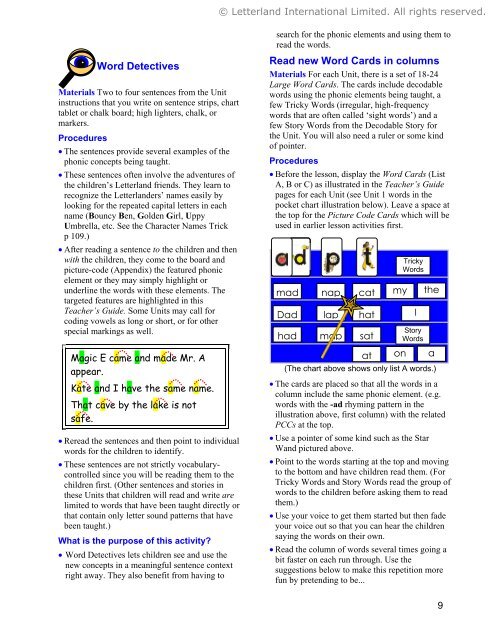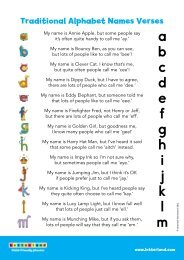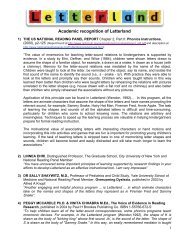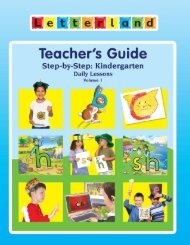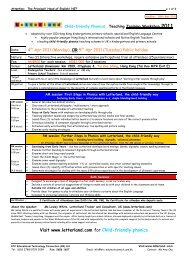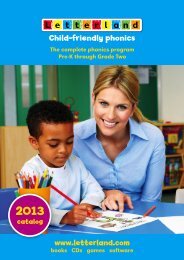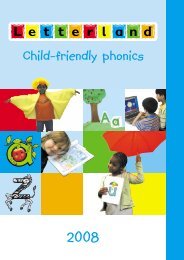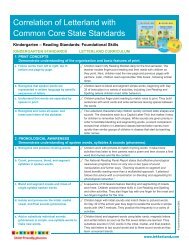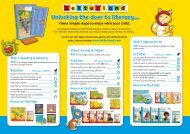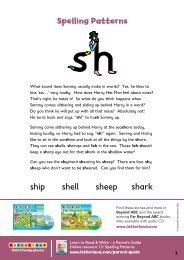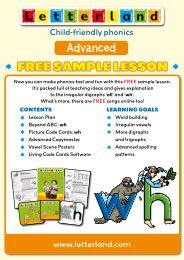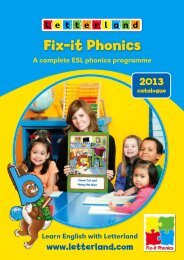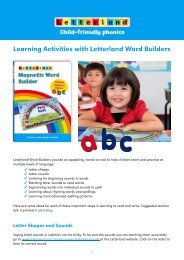Teacher's Guide - Letterland
Teacher's Guide - Letterland
Teacher's Guide - Letterland
You also want an ePaper? Increase the reach of your titles
YUMPU automatically turns print PDFs into web optimized ePapers that Google loves.
© <strong>Letterland</strong> International Limited. All rights reserved.search for the phonic elements and using them toread the words.Word DetectivesMaterials Two to four sentences from the Unitinstructions that you write on sentence strips, charttablet or chalk board; high lighters, chalk, ormarkers.Procedures• The sentences provide several examples of thephonic concepts being taught.• These sentences often involve the adventures ofthe children’s <strong>Letterland</strong> friends. They learn torecognize the <strong>Letterland</strong>ers’ names easily bylooking for the repeated capital letters in eachname (Bouncy Ben, Golden Girl, UppyUmbrella, etc. See the Character Names Trickp 109.)• After reading a sentence to the children and thenwith the children, they come to the board andpicture-code (Appendix) the featured phonicelement or they may simply highlight orunderline the words with these elements. Thetargeted features are highlighted in thisTeacher’s <strong>Guide</strong>. Some Units may call forcoding vowels as long or short, or for otherspecial markings as well.Magic E came and made Mr. Aappear.Kate and I have the same name.That cave by the lake is notsafe.• Reread the sentences and then point to individualwords for the children to identify.• These sentences are not strictly vocabularycontrolledsince you will be reading them to thechildren first. (Other sentences and stories inthese Units that children will read and write arelimited to words that have been taught directly orthat contain only letter sound patterns that havebeen taught.)What is the purpose of this activity?• Word Detectives lets children see and use thenew concepts in a meaningful sentence contextright away. They also benefit from having toRead new Word Cards in columnsMaterials For each Unit, there is a set of 18-24Large Word Cards. The cards include decodablewords using the phonic elements being taught, afew Tricky Words (irregular, high-frequencywords that are often called ‘sight words’) and afew Story Words from the Decodable Story forthe Unit. You will also need a ruler or some kindof pointer.Procedures• Before the lesson, display the Word Cards (ListA, B or C) as illustrated in the Teacher’s <strong>Guide</strong>pages for each Unit (see Unit 1 words in thepocket chart illustration below). Leave a space atthe top for the Picture Code Cards which will beused in earlier lesson activities first.madDadnaplapcathatmyTrickyWordsStoryhad map sat Wordsat on a(The chart above shows only list A words.)• The cards are placed so that all the words in acolumn include the same phonic element. (e.g.words with the -ad rhyming pattern in theillustration above, first column) with the relatedPCCs at the top.• Use a pointer of some kind such as the StarWand pictured above.• Point to the words starting at the top and movingto the bottom and have children read them. (ForTricky Words and Story Words read the group ofwords to the children before asking them to readthem.)• Use your voice to get them started but then fadeyour voice out so that you can hear the childrensaying the words on their own.• Read the column of words several times going abit faster on each run through. Use thesuggestions below to make this repetition morefun by pretending to be...Ithe9


